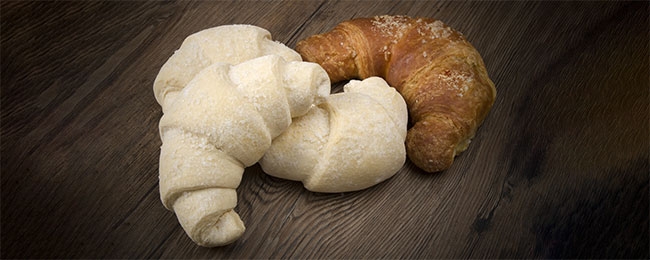
Frozen Dough: Q&A
June 18, 2019
By Janice Best and Naomi Szeben
What you need to know about working with refrigerated or frozen dough
 Frozen dough and pastry can save time and floor-space for groceries and small cafés that don’t have room for working with laminated, raw dough. Bakers Journal Q&A on frozen dough helps small bakeries offer fresh options without compromising food safety or flavour. Photo: Adobe Stock
Frozen dough and pastry can save time and floor-space for groceries and small cafés that don’t have room for working with laminated, raw dough. Bakers Journal Q&A on frozen dough helps small bakeries offer fresh options without compromising food safety or flavour. Photo: Adobe StockJanice Best spoke with Bakers Journal to learn about the best way to work with frozen, or refrigerated dough. What is the safest way to use it? Can it be re-frozen safely?
Does the type of dough affect the way it is frozen? How long is the average shelf-life of frozen pastry or bread dough?
Bakers Journal shares insights in to bringing out the best of your products using frozen dough.
Bakers Journal / What are the main safety concerns for storing and using frozen dough?
Janice Best / In the frozen state, doughs are well preserved from a food safety perspective – meaning freezing such dough will inhibit any pathogen growth but will not destroy any pathogens that are already present. As a result, freezing dough does not make a raw dough safer. Proper handling and complete cooking or baking are both required to provide a safe end product for consumption.
BJ / Are there any differences in storing/using frozen phyllo, flatbread or chop-croute (flaky pastry dough)?
Best / While there are different quality considerations for various dough types, freezing allows for safe storage of all doughs.
BJ / How should un-used leftover frozen dough be used?
Best / Safe handling practices for frozen dough that has been thawed are to refrigerate it and use it within a short period of time, or – if you’re unable to use it quickly – refreeze it immediately, understanding that the quality of the dough could degrade.
BJ / What time frame should dough have before it gets used (what is its best-before date)?
Best / With yeast-containing frozen dough, the flour should be high in protein and of good quality. As it ages, the yeast dies and leaches glutathione, destroying the gluten network. With proper yeast and protein levels, and a freeze to thaw cycle less than three days, frozen dough should perform well up to four months. After four months, quality may decline. The producer will determine the optimal shelf life. Non-yeast doughs can last up to a year and can be refrozen if wrapped and stored properly.
BJ / What is the longest (average) time frame for frozen dough’s storage?
Best / There are a couple of issues at play with shelf life: food safety and product functionality. Food safety is not an issue as long as it stays frozen, and the dough is thoroughly cooked or baked prior to consuming. The typical shelf life of frozen doughs is 6 months. After that, there can be challenges with bake volume and getting the desired light, airy textures becomes more difficult. However, some frozen doughs can have a one-year shelf life.
Janice Best is the director of product development and technical solutions Canada at Ardent Mills.
Print this page
Leave a Reply